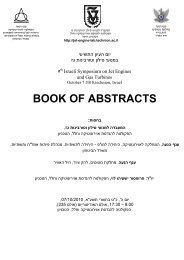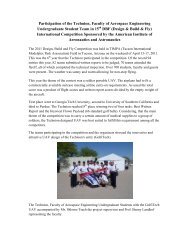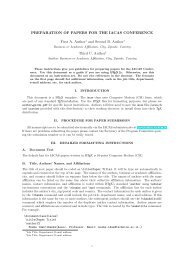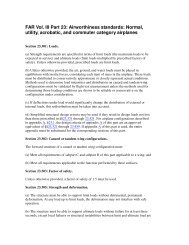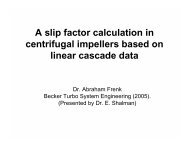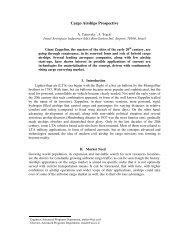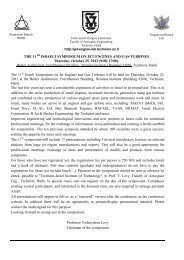A Century of Ramjet Propulsion Technology Evolution - Faculty of ...
A Century of Ramjet Propulsion Technology Evolution - Faculty of ...
A Century of Ramjet Propulsion Technology Evolution - Faculty of ...
You also want an ePaper? Increase the reach of your titles
YUMPU automatically turns print PDFs into web optimized ePapers that Google loves.
at speeds <strong>of</strong> over 10,000 mph, the spacecraft would descend and<br />
encounter the upper atmosphere. The pilot would execute a high-g<br />
pullout as the craft skipped <strong>of</strong>f the atmosphere like a stone skipping<br />
on water. This cycle would be repeated several times as the vehicle<br />
slowed and descended on its global path. When it neared its target,<br />
the spacecraft would release a large conventional-explosive bomb<br />
that would enter the atmosphere at meteor speeds and strike with<br />
tremendous force. No reference source on the Sänger–Bredt project<br />
indicates that any RaBo hardware was built at L<strong>of</strong>er. A 1947 U.S.<br />
technical intelligence manual on the L<strong>of</strong>er base, however, contains<br />
an image <strong>of</strong> an incomplete nose and forward fuselage <strong>of</strong> a very<br />
unconventional aircraft that was never flown.<br />
During and shortly after WWII, the United State developed<br />
a number <strong>of</strong> airbreathing-propelled drones. One example is the<br />
1942 McDonald-developed Katydid KDH-1 pulsejet-powered target<br />
drone, whose design heritage appears to follow from the German<br />
V-1. Unknown quantities <strong>of</strong> drones were produced.<br />
In the United States, the Marquardt Company, founded by R.<br />
Marquardt, began developing ramjet engines in 1944. Shortly after<br />
WWII, the U.S. military services developed and tested subsonic<br />
ramjet engines for a series <strong>of</strong> experimental applications. The propulsion<br />
goal in these early days <strong>of</strong> turbojet propulsion was to achieve<br />
low-cost airbreathing engines. Flight testing <strong>of</strong> these subsonic ramjets<br />
required only aircraft assist to reach ramjet flight speed. 35 Early<br />
interests in ramjet propulsion for high-speed subsonic aircraft applications<br />
led to two piloted experimental flight demonstrators. The<br />
first <strong>of</strong> these, conducted in 1946, employed a North American P-<br />
51 Mustang as the carrier aircraft with its dual-wingtip-mounted<br />
Marquardt subsonic ramjets. The second, flown in 1948, used the<br />
higher speed turbojet-powered Lockheed F-80 Shooting Star fighter.<br />
The ramjets were typically started fuel rich to achieve maximum<br />
thrust, accounting for the extended exhaust flames that diminished<br />
as flight speed increased. The F-80 briskly accelerated on ramjet<br />
power, with the turbojet set at idle. Larger 48-in.-diam experimental<br />
subsonic ramjets were subsequently developed and flown experimentally<br />
on the Douglas B-26 and demonstrated the potential for<br />
engine scale-up and added thrust. Subsonic ramjets were applied to<br />
production target drones and experimental missiles during this period.<br />
A leading example was the U.S. Navy Gorgon IV test vehicle<br />
first flown in 1947. Both this prototype missile and the derivative<br />
KDM-1 Plover target drone were powered by a single 20-in. ramjet<br />
burning gasoline and used parachute recovery permitting reuse <strong>of</strong><br />
the vehicle.<br />
The U.S. Navy Cobra was the first successful demonstration <strong>of</strong> a<br />
ramjet in supersonic flight, occurring in 1945. Cobra is a 6-in.-diam,<br />
normal shock inlet, tandem-boosted, liquid propylene oxide-fueled<br />
ramjet flight test vehicle that cruised at Mach 2 at 20,000-ft altitude.<br />
Its purpose was to demonstrate that a ramjet could produce the<br />
requisite thrust to cruise at supersonic speeds.<br />
The U.S. Navy Bureau <strong>of</strong> Aeronautics developed an entire family<br />
<strong>of</strong> unmanned guided drone missiles under the name <strong>of</strong> Gordon between<br />
1943 and 1953 for a variety <strong>of</strong> tasks, including ground attack<br />
and interception <strong>of</strong> bomber formations. In the mid-1940s, piston<br />
engines yielded insufficient performance and new ramjet and turbojet<br />
propulsion were beginning to show promise. Development <strong>of</strong><br />
a ramjet-powered Gordon IV began in 1945 using the Marquardt<br />
XRJ30-MA ramjet engine, a derivative <strong>of</strong> which supported the Bomarc<br />
missile development a few years later. The swept-wing KDM-1<br />
with an underslung ramjet first flew in 1947. There were 12 vehicles<br />
were produced and operational until 1949, when the hardware<br />
was used to develop a later version called Plover. The program was<br />
canceled in 1953 as advanced missile technology was developed.<br />
Considerably less sophisticated normal shock inlets were used<br />
in the early history <strong>of</strong> ramjet engines. These were the real flying<br />
stovepipes with no moving parts and advertised as the simplest<br />
propulsion system known to man. The focus shifted from the ultrasimplicity<br />
<strong>of</strong> the normal shock ramjet in the mid-1950s to the<br />
supersonic inlet ramjet engine as employed in the Bomarc.<br />
These subsonic ramjet flight test successes led to subsequent supersonic<br />
ramjet system developments. To do so, with only subsonic<br />
aircraft being available, required the use <strong>of</strong> rocket boosters. The op-<br />
FRY 41<br />
Fig. 11 U.S. NAVAHO operational missile (1946–1958).<br />
erational Bomarc and Talos interceptor missiles were derived from<br />
this advancement in propulsion technology. Marquardt developed<br />
the engines for the Bomarc missile, producing over 1600 units in<br />
various versions. The ramjet-powered Navaho and Talos missiles<br />
were developed in this same era. Escher and Foreman 36 assembled<br />
a recent excellent review <strong>of</strong> these missile systems and recount useful<br />
technical and program information.<br />
The Navaho supersonic cruise missile (Fig. 11), developed in the<br />
1950s for intercontinental ranges, was massive in size. At 48-in.<br />
diameter, 90 ft long and weighing in at 120,000 lbm, it is the largest<br />
ramjet engine developed in the United States. The missile used two<br />
engines mounted side-by-side, with each connected to an airflow<br />
duct leading from each <strong>of</strong> the two fuselage-side-mounted half-cone<br />
equipped inlets. The engines burned JP-4 or JP-5. The development<br />
program was canceled in 1957 due to its high cost together with<br />
improvements in surface-to-air missile (SAM) technology and the<br />
successful development <strong>of</strong> intercontinental ballistic missiles over<br />
supersonic cruise missiles.<br />
Russia developed the Burya (storm) missile in parallel with the<br />
U.S. Navaho. Designed to be an intercontinental strategic missile,<br />
the Burya employed an LFRJ cycle and two tandem boosters that<br />
used kerosene/nitric acid fuel. Five successful flight tests <strong>of</strong> the<br />
Mach 3 missile reportedly occurred. The development was canceled<br />
in 1958, shortly after development <strong>of</strong> the Navaho was stopped.<br />
The Bomarc and Talos antiaircraft interceptor systems were fully<br />
developed and operationally deployed by the U.S. Air Force and<br />
U.S. Navy, respectively. These rocket-boosted hydrocarbon-fueled<br />
ramjet-powered vehicles and derivatives routinely achieved speeds<br />
<strong>of</strong> Mach 2–3+ and altitudes from sea level to 40,000–70,000 ft and<br />
higher. In doing so, they recorded high degrees <strong>of</strong> mission reliability<br />
and operational effectiveness. The Bomarc supersonic interceptor<br />
missile (Fig. 12), deployed in the early 1960s by the U.S. Air Force<br />
and the Royal Canadian Air Force, employed two variations <strong>of</strong> a<br />
fixed-geometry ramjet engine. The A-series missile employed an<br />
axisymmetric cone-configured mixed compression inlet and annular<br />
air-cooled combustor that burned 80-octane gasoline. The B-series<br />
missile was fitted with an isentropic-configured fixed-inlet spike and<br />
burned JP-4 fuel. Launched vertically, the Bomarc interceptor rolled<br />
to its flyout azimuth, pitched over and accelerated to flight speeds <strong>of</strong><br />
Mach 2.5–2.7 and altitudes <strong>of</strong> 65,000–70,000 ft under ramjet power.<br />
The ramjet engine was later certified for Mach 3.4 service.<br />
In the early 1950s, after the need for a supersonic experimental<br />
research and flight demonstration vehicle was recognized, the<br />
United States initiated the X-7 program. This air-launched solidrocket-boosted<br />
supersonic vehicle initially used several Bomarc<br />
hydrocarbon-fueled conventional ramjet engines ranging in size<br />
from 28 to 36 in. in diameter and achieved flight conditions <strong>of</strong> Mach<br />
4.3 and 84,000 ft. Flown from 1952 to 1959, the X-7 was designed






